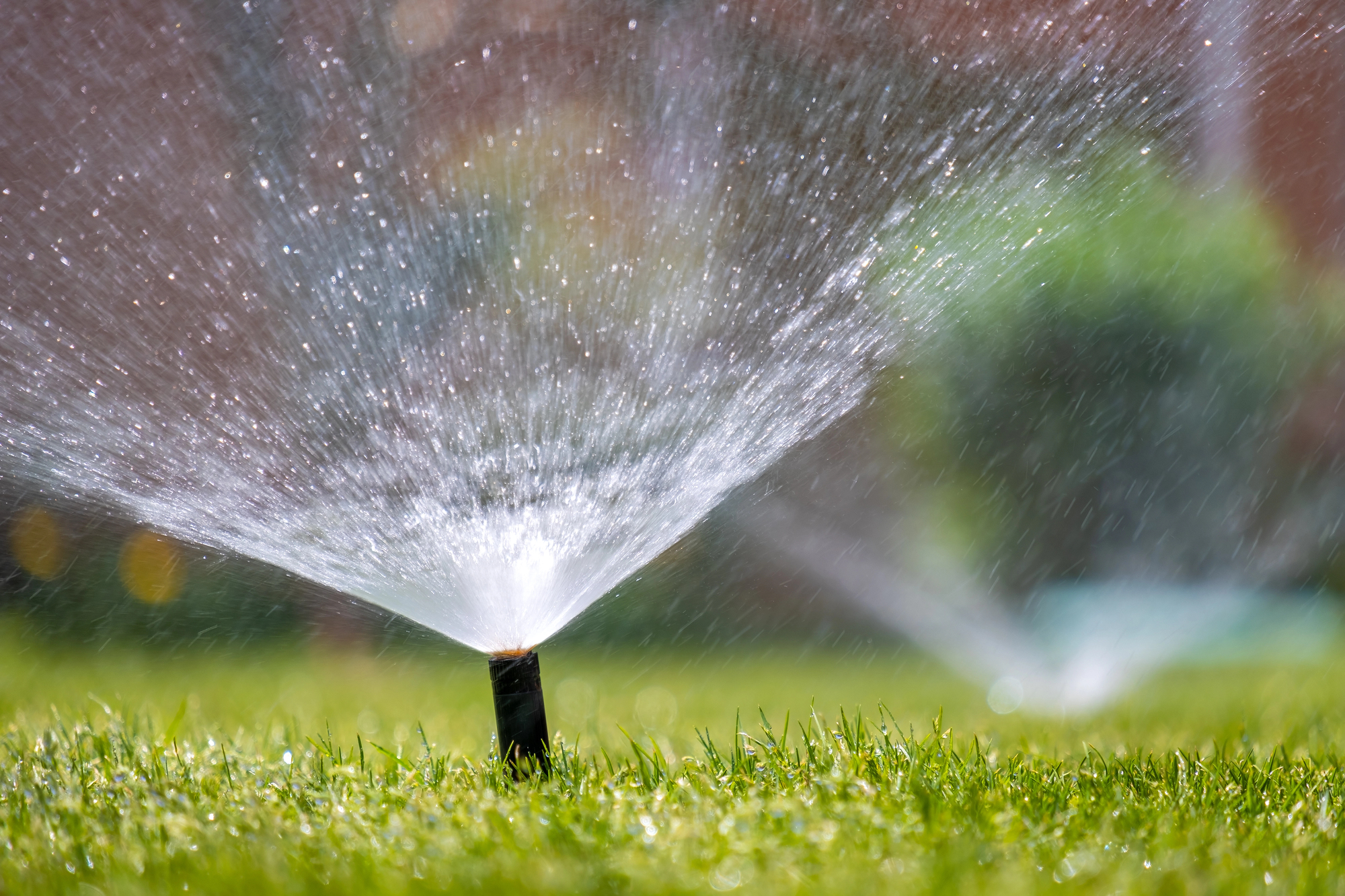As spring transitions into summer, maintaining a lush, green lawn becomes a priority for many homeowners. Proper watering techniques are essential for lawn health, especially during the warmer months when heat stress can damage grass. Avoiding common watering mistakes now can save your lawn from becoming patchy, brown, or diseased before summer fully arrives.
Many people unknowingly harm their lawns through incorrect watering practices, whether it’s watering too frequently, at the wrong time of day, or with improper amounts. These errors can lead to shallow root systems, fungal growth, or wasted water. Understanding these common mistakes is the first step toward developing a watering routine that promotes a resilient, healthy lawn throughout the summer season.
1) Watering during peak sunlight hours causing evaporation
Watering your lawn between 10 am and 4 pm can waste a significant amount of water. During these hours, the sun is at its strongest, causing water to evaporate before it can properly penetrate the soil and reach the roots.
The heat of the day increases the rate of evaporation, meaning your grass receives less moisture despite using the same amount of water. This inefficient practice not only wastes water but also leaves your lawn vulnerable to drought stress.
Water droplets on grass blades can act like tiny magnifying glasses in direct sunlight. This may lead to burned patches on your lawn as the droplets concentrate the sun’s rays onto the grass.
Early morning watering, between 4 am and 9 am, is considered the best time. The cooler temperatures allow water to soak into the soil before evaporation occurs, and plants have time to dry before evening, reducing disease risk.
Evening watering might seem logical but can encourage fungal growth. Water sitting on grass overnight creates humid conditions that may lead to lawn diseases, particularly in warm weather.
2) Using a sprinkler with uneven coverage
Uneven water distribution across your lawn can lead to patchy growth and dry spots. When sprinklers fail to provide consistent coverage, some areas receive too much water while others remain dry, creating an unattractive, inconsistent lawn appearance.
Sprinkler heads often develop problems that affect their coverage patterns. Clogged nozzles, misaligned heads, or incorrect pressure settings can all contribute to poor water distribution. These issues might seem minor but can significantly impact lawn health.
Testing your sprinkler system regularly helps identify coverage gaps. Place small containers at various points across your lawn and run the system for a set time. The water depth in each container should be roughly equal if coverage is uniform.
Overlapping sprinkler zones by about 30% ensures complete coverage. Without proper overlap, you’ll notice dry patches between sprinkler reach areas, especially during hot weather when your grass needs water most.
Consider replacing outdated sprinkler heads with newer models that offer more consistent spray patterns. Modern rotary nozzles often provide better coverage than older fixed-spray models and can reduce water waste significantly.
3) Overwatering leading to fungal diseases
Many homeowners unknowingly damage their lawns by providing too much water. Excess moisture creates the perfect breeding ground for fungal pathogens that can quickly spread throughout your grass.
Common lawn fungi include brown patch, dollar spot, and powdery mildew. These organisms thrive in consistently wet conditions, especially when water sits on grass blades for extended periods.
Signs of fungal infection include discoloured patches, thinning grass, and visible mould growth. Once established, these diseases can be difficult and expensive to eliminate.
The best approach is prevention through proper watering habits. Water deeply but infrequently, allowing the soil to dry slightly between waterings.
Morning is the ideal time to water your lawn. This gives excess moisture time to evaporate during the day, reducing the risk of fungal development.
Pay attention to weather forecasts and adjust your watering schedule accordingly. Skip irrigation when rain is expected to avoid creating waterlogged conditions.
If you notice signs of fungal disease, reduce watering immediately and consider applying an appropriate fungicide. In severe cases, you might need to consult a lawn care professional for treatment options.
4) Ignoring soil moisture before watering
Many gardeners water their lawns on a fixed schedule without checking soil moisture levels first. This approach wastes water and can harm your grass. Different soil types retain moisture differently, and weather conditions change constantly.
The best way to determine if your lawn needs water is to check the soil moisture directly. You can use a simple soil moisture meter or try the screwdriver test – if a screwdriver easily penetrates 6 inches into the soil, your lawn likely has enough moisture.
Watering when the soil is already wet leads to several problems. It creates waterlogged conditions that can suffocate grass roots. Excess water also encourages fungal diseases and shallow root development, making your lawn less drought-resistant.
Different areas of your lawn may have different moisture needs. Low spots tend to stay wetter, while sloped areas dry out faster. Check multiple spots before deciding to water.
In clay soils, water takes longer to penetrate but stays available longer. Sandy soils drain quickly and need more frequent but lighter watering. Understanding your soil type helps you make better watering decisions.
5) Watering too infrequently causing drought stress
Drought stress occurs when lawns don’t receive enough water to maintain healthy growth. Many homeowners underestimate how much water their grass actually needs, especially during hot, dry periods.
Signs of drought stress include a bluish-grey colour, footprints remaining visible after walking on the lawn, and grass blades that fold in half lengthwise. These indicators appear before the grass turns brown and goes dormant.
Different grass types have varying water requirements. Cool-season grasses like fescue and ryegrass need more frequent watering than warm-season varieties such as Bermuda or zoysia.
The ideal watering schedule depends on your local climate and soil type. As a general rule, most lawns need about 2.5 cm of water per week, either from rainfall or irrigation.
Deep, infrequent watering is better than frequent shallow watering, but don’t take this too far. Waiting until your lawn shows severe drought symptoms can stress the grass and make it vulnerable to disease and weed invasion.
Sandy soils drain quickly and may require more frequent watering, while clay soils retain moisture longer. Adjust your watering schedule accordingly to prevent drought stress from weakening your lawn.
The Impact Of Improper Watering On Lawn Health
Incorrect watering practices can damage your lawn significantly, affecting both its appearance and long-term health. Water management directly influences root development, nutrient uptake, and resilience against pests and diseases.
How Soil Type Affects Moisture Retention
Different soil types require distinct watering approaches. Clay soils retain moisture longer but become compacted when overwatered, reducing oxygen availability to roots. Sandy soils drain quickly and may need more frequent watering in smaller amounts.
A simple test to determine your soil type:
- Take a handful of moist soil
- Squeeze it firmly
- Open your hand
Results meaning:
- If it holds shape and feels sticky = Clay soil
- If it falls apart immediately = Sandy soil
- If it holds shape but crumbles when poked = Loamy soil (ideal)
Clay soils benefit from less frequent but deeper watering sessions. This prevents waterlogging while encouraging roots to grow deeper for nutrients and moisture.
Sandy soils require shorter, more frequent watering cycles. Without proper moisture management, lawns in sandy soil can develop dry patches and become prone to heat stress.
Understanding The Role Of Lawn Grass Varieties
Different grass types have varying water requirements and drought tolerance levels. Cool-season grasses like Kentucky bluegrass and ryegrass typically need more consistent moisture than warm-season varieties such as Bermuda or Zoysia.
Water needs by grass type:
| Grass Type | Water Requirement | Drought Tolerance |
|---|---|---|
| Kentucky Bluegrass | High | Low |
| Tall Fescue | Medium | Medium-High |
| Bermuda | Medium | High |
| Zoysia | Low-Medium | High |
Cool-season grasses often struggle during summer heat without proper irrigation. Their shallow root systems make them vulnerable to drought stress when improperly watered.
Warm-season grasses can withstand longer periods without water but still require appropriate irrigation during extended dry spells. These varieties go dormant rather than die when underwatered, turning brown temporarily.
Matching your watering schedule to your specific grass type prevents wasteful overwatering and reduces stress on the plants. Regular, deep watering encourages deeper root growth in all varieties, improving drought resistance.
Correcting Watering Techniques For A Healthy Lawn
Proper watering techniques can save your lawn from potential damage and promote healthy growth. By understanding timing, equipment choices and soil conditions, you can develop an effective watering routine.
Utilising Timers And Sprinkler Systems Efficiently
Automated watering systems offer convenience but require proper setup. Set timers to water early in the morning, ideally between 4-7am, when wind is minimal and evaporation rates are low. This timing allows water to soak into the soil before the day heats up.
Adjust sprinkler heads to ensure even coverage without wasteful overlapping. Check regularly for blocked nozzles or misaligned heads that might create dry patches or overwatered areas.
Programme different zones based on sun exposure. South-facing areas typically need more water than shaded northern spots. Most lawns benefit from deeper, less frequent watering rather than daily light sprinkles.
Consider installing rain sensors that automatically skip scheduled watering after rainfall. This simple addition can save significant amounts of water and prevent waterlogging.
Measuring Soil Moisture Accurately
Correct moisture assessment prevents both underwatering and overwatering. Use a simple soil probe or moisture meter to check dampness before watering. Insert the tool about 15cm into the soil to determine moisture levels below the surface.
The screwdriver test offers a quick alternative. If a screwdriver slides easily into the soil, moisture levels are likely adequate. If it meets resistance, watering may be necessary.
Different soil types require varied approaches. Clay soils retain water longer but absorb it slowly, so water gently to prevent runoff. Sandy soils drain quickly and may need more frequent watering in smaller amounts.
Observe grass response as an indicator of water needs. Footprints that remain visible or grass blades that fold are early signs of drought stress. Colour changes from vibrant green to blue-grey suggest immediate watering is needed.





